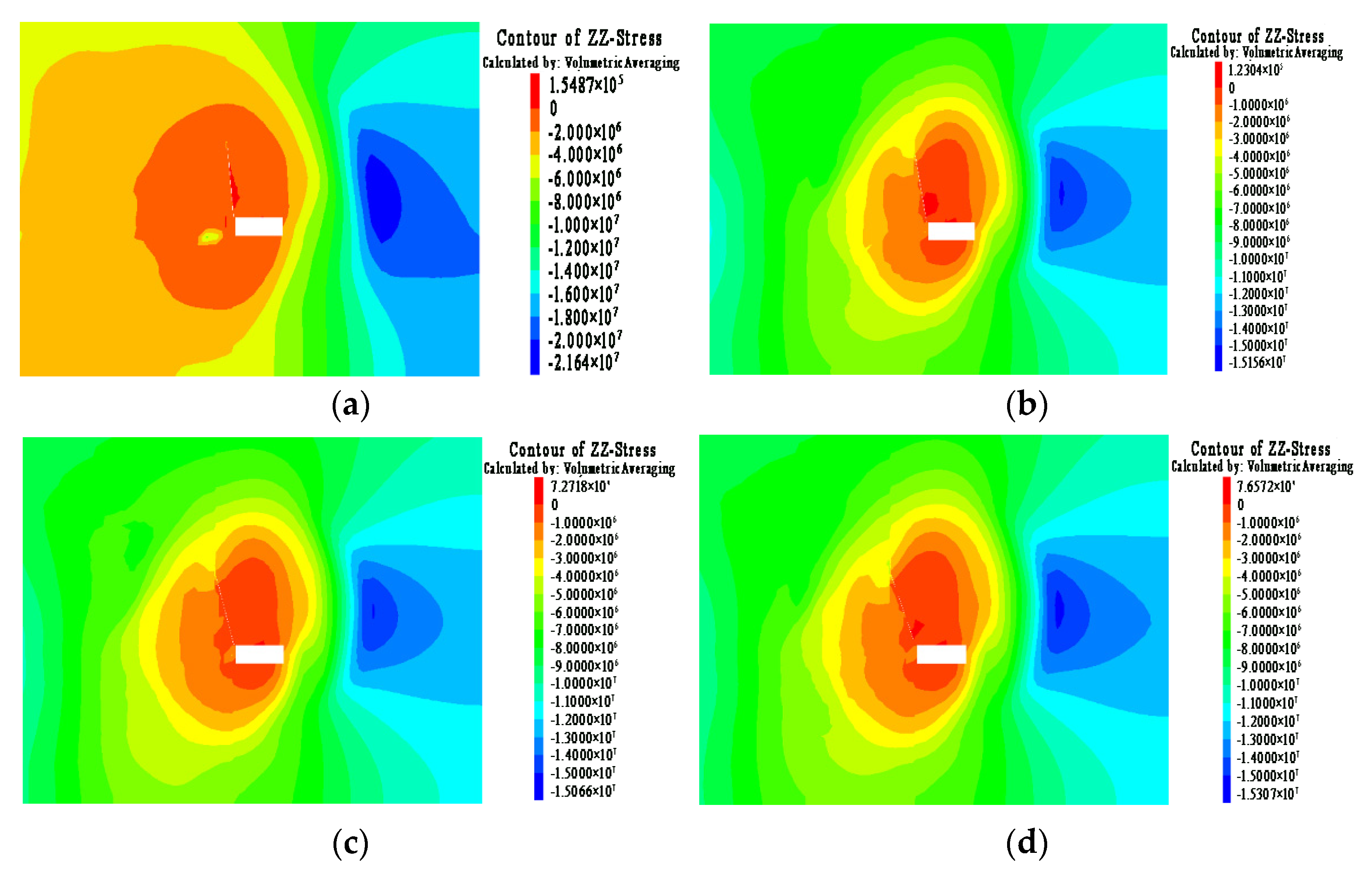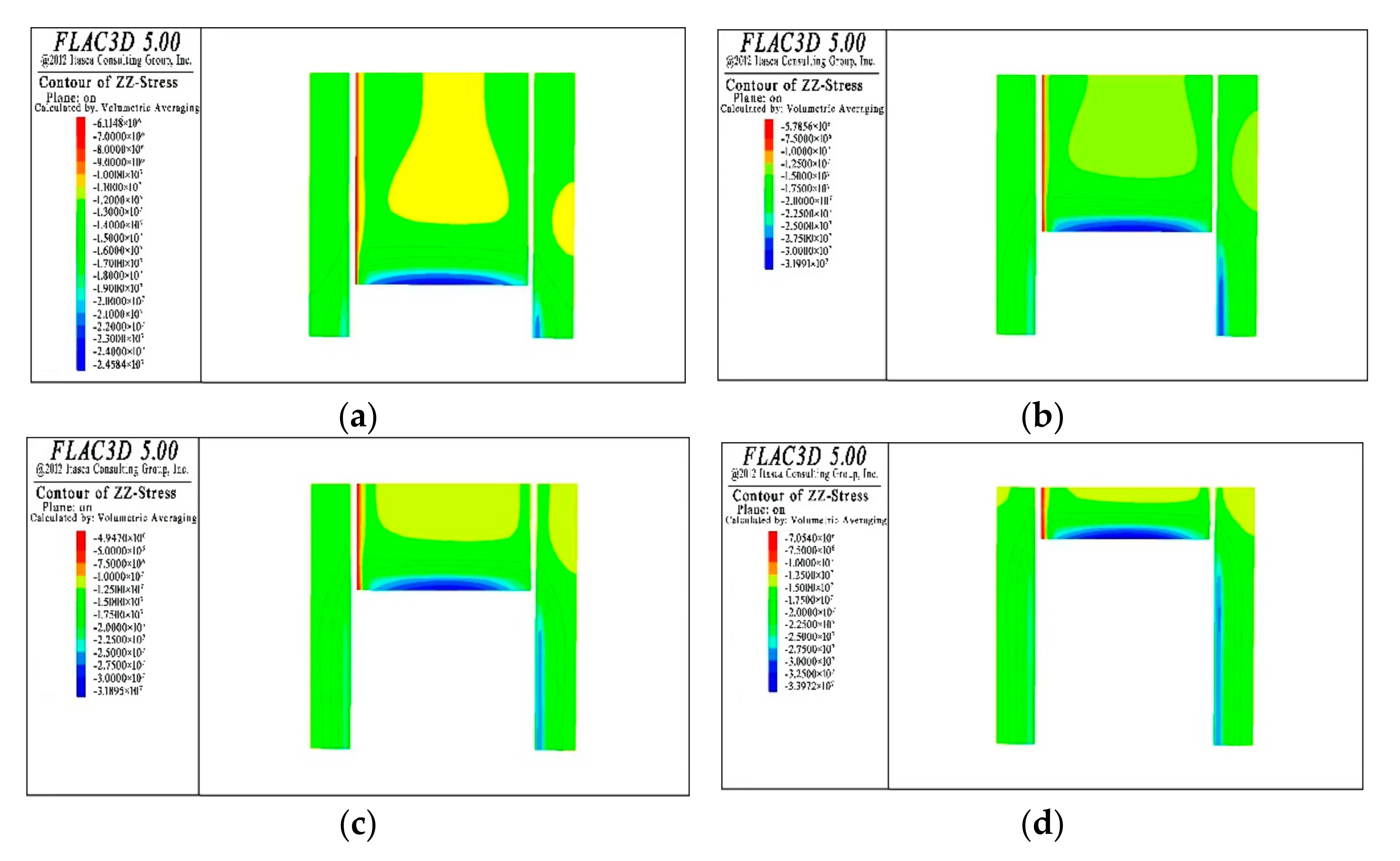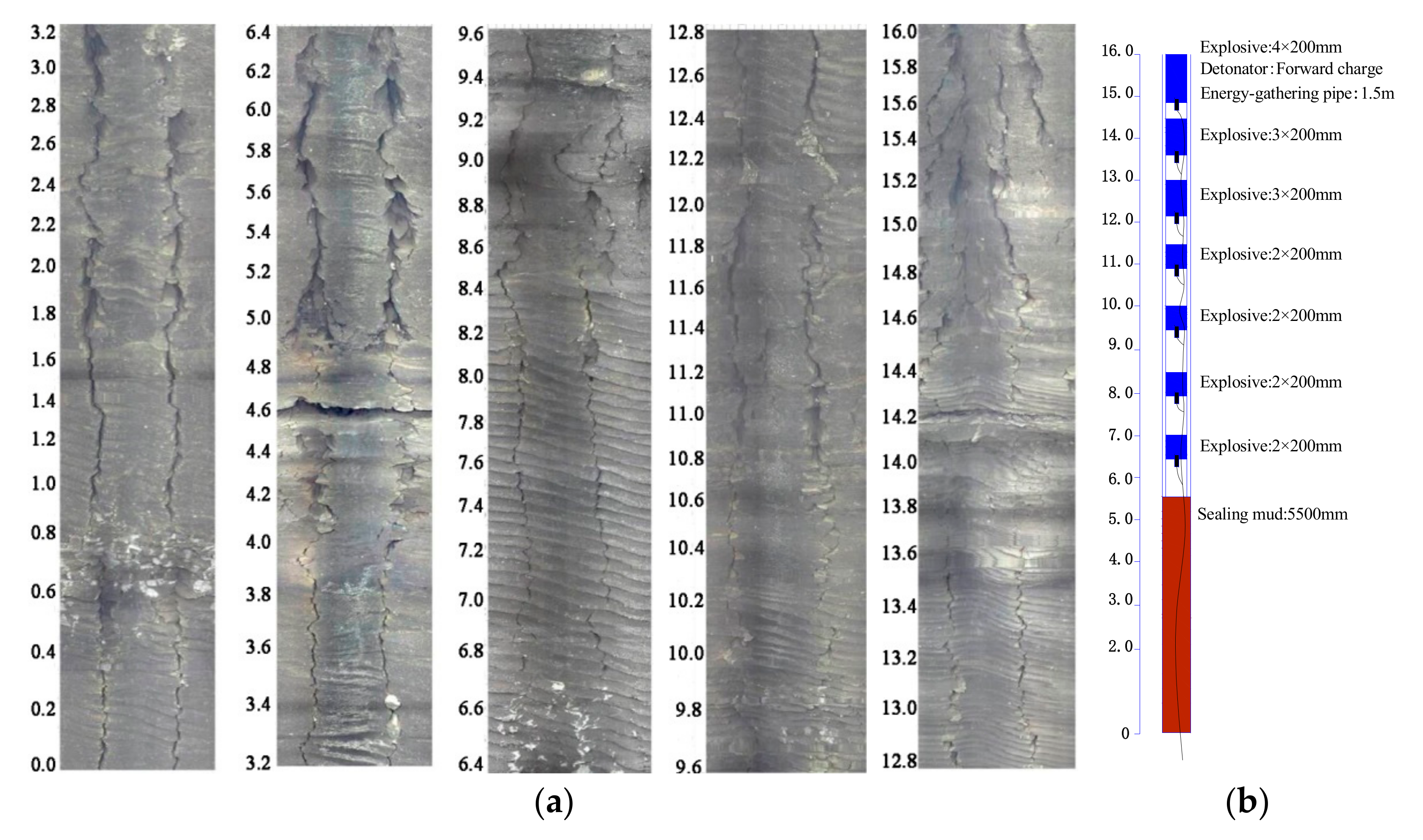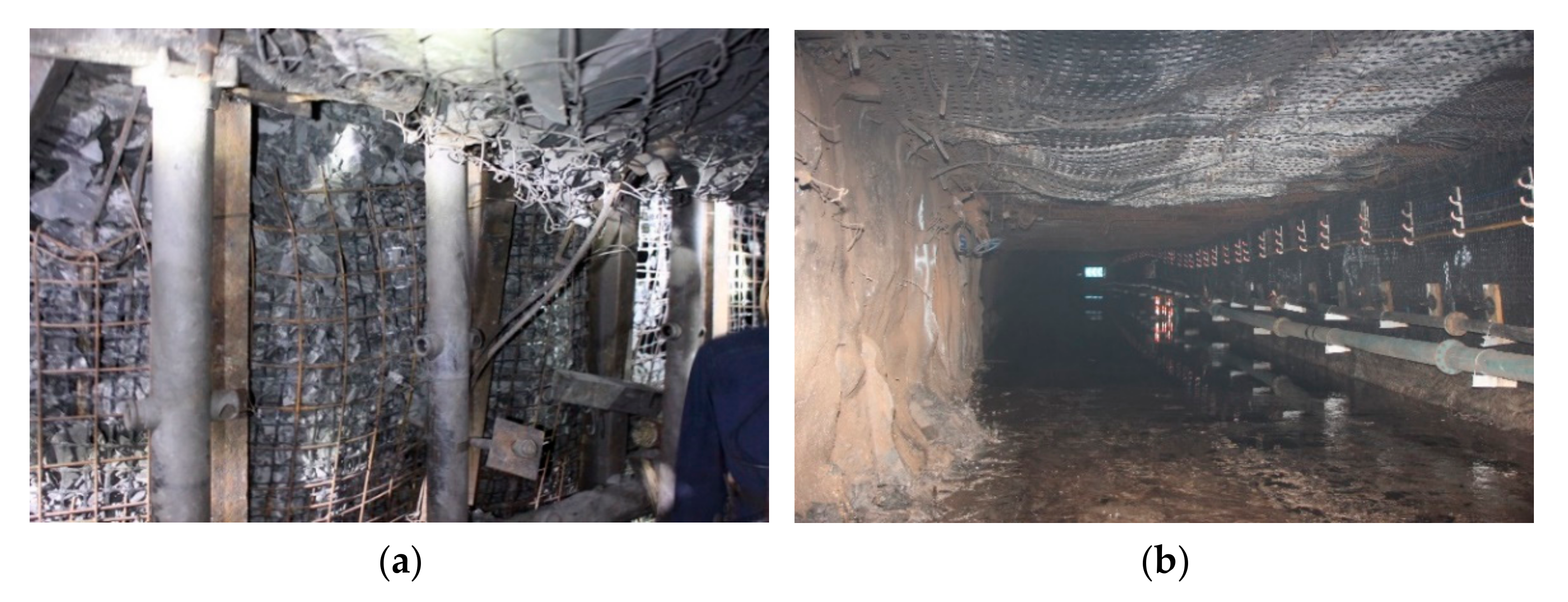Research on the Key Technology of Gob-Side Entry Retaining by Roof Cutting for Thick and Hard Sandstone Roofs
Abstract
:1. Introduction
2. Key Technology of Gob-Side Entry Retaining by Roof Cutting
2.1. Process Flow of Gob-Side Entry Retaining by Roof Cutting
2.2. Key Technology of Gob-Side Entry Retaining by Roof Cutting
3. Research on Presplit Blasting Technology
3.1. The Height of the Roof Cutting
3.2. The Angle of the Roof Cutting
3.3. The Effect of Pressure Relief by Roof Cutting
4. Special Technical Measures for Thick and Hard Sandstone Roofs
- (1)
- The Diameter of the Blasting Hole
- (2)
- The Spacing of the Blasting Hole
- (3)
- The Depth of the Blasting Hole
- (4)
- The Blast Cycle Interval
5. Engineering Application
6. Conclusions
- LS-DYNA numerical simulation software was used to analyze the blasting effect under two working conditions with and without the energy-gathering pipe. The results showed that the surrounding rock cracks in a single horizontal direction under the action of the detonation wave when using the energy-gathering pipe, which could achieve the purpose of directional roof cutting.
- By theoretical analysis and numerical simulation, it was determined that the optimal height of roof cutting was 16 m, and the optimal angle of roof cutting was 15°. FLAC3D numerical simulation software was used to analyze the stress distribution of the working face. The results showed that the vertical stress near the roof cutting side was much less than that of the other side without roof cutting. The effect of pressure relief by roof cutting was good.
- It was proposed to use deep hole loosening blasting to make the thick and hard sandstone roof collapse in time to fill the gob. A group of blasting holes was arranged every 20 m in the roadway with roof cutting, and each group of blasting holes consisted of two blasting holes. The depth of the #1 blasting hole was 47 m, and the angle with the horizontal direction was 20°; the depth of the #2 blasting hole was 65 m, and the angle with the horizontal direction was 15°. The two blasting holes were arranged perpendicular to the advancing direction of the working face, and the diameters of the blasting holes were both 50 mm.
- The field test of the 7135 ventilation roadway showed that the blasting with the energy-gathering pipe had a good effect of directional slitting; after deep hole loosening blasting, the thick and hard sandstone roof could collapse and fill the gob in time; the hydraulic support resistance of the working face in the side with roof cutting was much smaller than that of the side without roof cutting, and the effect of pressure relief by roof cutting was good.
Author Contributions
Funding
Institutional Review Board Statement
Informed Consent Statement
Data Availability Statement
Acknowledgments
Conflicts of Interest
References
- Zhang, K.; Liu, C.Y.; Zhang, H.R.; Yue, X.; Liu, H.D. Research on Roof Cutting Pressure Relief of the Gob-Side Entry Retaining With Roadside Backfilling. Front. Earth Sc-Switz 2022, 10, 835497. [Google Scholar] [CrossRef]
- Lou, Q.N.; Li, T.C.; Zhu, Q.W.; Wu, S.Y.; Yun, M.; Zhao, R.L. A Control Approach of the Roof in No-Pillar Roadway Formed by Roof Cutting and Pressure Releasing. Geofluids 2021, 2021, 1–14. [Google Scholar] [CrossRef]
- Wang, Y.J.; Yang, J.; He, M.C.; Tian, X.C.; Liu, J.N.; Xue, H.J.; Huang, R.F. Test of a liquid directional roof-cutting technology for pressure-relief entry retaining mining. J. Geophys. Eng. 2019, 16, 620–638. [Google Scholar] [CrossRef]
- Liu, X.; Hua, X.Z.; Yang, P.; Huang, Z.G. A study of the mechanical structure of the direct roof during the whole process of non-pillar gob-side entry retaining by roof cutting. Ener. Explor. Exploit. 2020, 38, 1706–1724. [Google Scholar] [CrossRef]
- Yang, X.J.; Hu, C.W.; He, M.C.; Wang, H.H.; Zhou, Y.B.; Liu, X.Y.; Zhen, E.Z.; Ma, X.G. Study on Presplitting Blasting the Roof Strata of Adjacent Roadway to Control Roadway Deformation. Shock Vib. 2019, 2019, 1–16 https://doi101155/2019/3174898. [Google Scholar] [CrossRef]
- Tu, M.; Zhao, G.M.; Zhang, X.Y.; Bu, Q.W.; Dang, J.X. Fracture Evolution between Blasting Roof Cutting Holes in a Mining Stress Environment. Minerals 2022, 12, 418. [Google Scholar] [CrossRef]
- He, M.C.; Wang, Q.; Wu, Q.Y. Innovation and future of mining rock mechanics. J. Rock Mech. Geotech. 2021, 13, 1–21 https://doi101016/jjrmge202011005. [Google Scholar] [CrossRef]
- Wang, E.Y.; Chen, X.D.; Yang, X.J. Research and Application of an Innovative 110 Mining Method in Gob-Side Half Coal Rock Entry Retaining. Shock Vib. 2021, 2021, 8228604. [Google Scholar] [CrossRef]
- Wang, Y.J.; Wang, Q.; Tian, X.C.; Wang, H.S.; Yang, J.; He, M.C. Stress and deformation evolution characteristics of gob-side entry retained by roof cutting and pressure relief. Tunn. Undergr. Sp. Tech. 2022, 123, 104419. [Google Scholar] [CrossRef]
- Zhang, Q.; He, M.C.; Guo, S.; Qi, J.C.; Yang, J.; Wang, C.; Xia, M.; Li, L.N. Investigation on the key techniques and application of the new-generation automatically formed roadway without coal pillars by roof cutting. Int. J. Rock Mech. Min. 2022, 152, 105058. [Google Scholar] [CrossRef]
- Li, Z.H.; Tao, Z.G.; Meng, Z.G.; He, M.C. Longwall mining method with roof-cutting unloading and numerical investigation of ground pressure and roof stability. Arab. J. Geosci. 2018, 11, 697. [Google Scholar] [CrossRef]
- Liu, X.Y.; He, M.C.; Wang, J.; Ma, Z.M. Research on Non-Pillar Coal Mining for Thick and Hard Conglomerate Roof. Energies 2021, 14, 299. [Google Scholar] [CrossRef]
- Yan, S.; Liu, T.X.; Bai, J.B.; Wu, W.D. Key Parameters of Gob-Side Entry Retaining in A Gassy and Thin Coal Seam with Hard Roof. Processes 2018, 6, 51. [Google Scholar] [CrossRef]
- Hu, C.W.; Yang, X.J.; Huang, R.F.; Ma, X.G. Presplitting Blasting the Roof Strata to Control Large Deformation in the Deep Mine Roadway. Adv. Civ. Eng. 2020, 2020, 1–15. [Google Scholar] [CrossRef]
- Tai, Y.; Yu, B.; Xia, B.W.; Li, Z.; Xia, H.C. Research on stress release for the gob-side roadway using the roof-cutting technology with a chainsaw arm. Roy. Soc. Open Sci. 2020, 7, 191663. [Google Scholar] [CrossRef] [PubMed]
- Sun, B.J.; Hua, X.Z.; Zhang, Y.; Yin, J.D.; He, K.; Zhao, C.X.; Li, Y.F. Analysis of Roof Deformation Mechanism and Control Measures with Roof Cutting and Pressure Releasing in Gob-Side Entry Retaining. Shock Vib. 2021, 2021, 1–13. [Google Scholar] [CrossRef]
- Xu, T.; Zhang, G.H.; Cheng, T.; Wang, Y.J. Simulation Research on the Surrounding Rock Stability of Gob Side Entry Retaining with Roof Cutting and Pressure Relief Based on Ecological Environment of Coal Mining. Fresen. Environ. Bull. 2021, 30, 11263–11270. [Google Scholar]
- Gao, H.N.; Gao, Y.B.; Wang, J.; Fu, Q.; Qiao, B.W.; Wei, X.J.; Zhang, X.Y. Study on Bidirectional Blasting Technology for Composite Sandstone Roof in Gob-Side Entry-Retaining Mining Method. Appl. Sci. 2021, 11, 7524. [Google Scholar] [CrossRef]
- Ge, J.J.; Xu, Y.; Huang, W.; Wang, H.B.; Yang, R.Z.; Zhang, Z.Y. Experimental Study on Crack Propagation of Rock by Blasting under Bidirectional Equal Confining Pressure Load. Sustainability 2022, 13, 2093 https://doi103390/su132112093. [Google Scholar] [CrossRef]
- Zhang, Q.; Wang, J.; Guo, S.; Gong, W.L.; Feng, L.F.; Wang, H.S.; Ming, C.; Ma, Z.M. Shaped Charge Hydraulic Blasting: An Environmental, Safe, and Economical Method of Directional Roof Cutting. Geofluids 2021, 2021, 1–20. [Google Scholar] [CrossRef]
- Yang, X.J.; Liu, C.K.; Sun, H.L.; Yue, S.L.; Ji, Y.G.; Zhang, X.Y.; Hou, L. Research on the Deformation Mechanism and Directional Blasting Roof Cutting Control Measures of a Deep Buried High-Stress Roadway. Shock Vib. 2020, 2020, 1–14. [Google Scholar] [CrossRef]
- Zhang, X.Y.; Hu, J.Z.; Xue, H.J.; Mao, W.B.; Gao, Y.B.; Yang, J.; He, M.C. Innovative approach based on roof cutting by energy-gathering blasting for protecting roadways in coal mines. Tunn. Undergr. Sp. Tech. 2020, 99, 103387. [Google Scholar] [CrossRef]
- Gao, K.; Huang, P.; Liu, Z.G.; Liu, J.; Wang, F.; Shu, C.M. Pressure Relief by Blasting Roof Cutting in Close Seam Group Mining under Thick Sandstone to Enhance Gas Extraction for Mining Safety. Processes 2021, 9, 603. [Google Scholar] [CrossRef]
- Ma, Z.Q.; Zhang, D.Y.; Cao, Y.Q.; Yang, W.; Xu, B. Study of Key Technology of Gob-Side Entry Retention in a High Gas Outburst Coal Seam in the Karst Mountain Area. Energies 2022, 15, 4161. [Google Scholar] [CrossRef]
- Yue, X.Z.; Tu, M.; Li, Y.F.; Chang, G.F.; Li, C. Stability and Cementation of the Surrounding Rock in Roof-Cutting and Pressure-Relief Entry under Mining Influence. Energies 2022, 15, 951. [Google Scholar] [CrossRef]
- Wang, Y.J.; Liu, J.N.; Yang, J.; Wang, Q.; Huang, R.F.; Tian, X.C.; He, M.C. Stability characteristics of a fractured high roof under nonpillar mining with an automatically formed roadway by using a visualized discrimination approach. Energy Sci. Eng. 2020, 8, 1541–1553. [Google Scholar] [CrossRef]
- Fu, B.J.; Tu, M.; Zhao, Q.C. Pressure Control Technology at the Hard Thick Sandstone Roof in an Island Mining Face with a Large Mining Height. Vjesn 2021, 27, 1863–1869. [Google Scholar] [CrossRef]
- Mondal, D.; Ghosh, S.; Naveen, P.; Kumar, M.; Majumder, A.; Panda, A.K. An integrated study on the geochemical, geophysical and geomechanical characteristics of the organic deposits (Coal and CBM) of eastern Sohagpur coalfield, India. Gondwana. Res. 2021, 96, 122–141. [Google Scholar] [CrossRef]
- Mondal, D.; Roy, P.N.S.; Kumar, M. Monitoring the strata behavior in the Destressed Zone of a shallow Indian longwall panel with hard sandstone cover using Mine-Microseismicity and Borehole Televiewer data. Eng. Geol. 2020, 271, 105593. [Google Scholar] [CrossRef]
- Wojtecki, L.; Mendecki, M.J.; Golda, I.; Zuberek, W.M. The Seismic Source Parameters of Tremors Provoked by Long-Hole Destress Blasting Executed During the Longwall Mining of a Coal Seam Under Variable Stress Conditions. Pure Appl. Geophys. 2020, 177, 5723–5739. [Google Scholar] [CrossRef]
- Xiang, Z.; Zhang, N.; Xie, Z.Z.; Guo, F.; Zhang, C.H. Cooperative Control Mechanism of Long Flexible Bolts and Blasting Pressure Relief in Hard Roof Roadways of Extra-Thick Coal Seams: A Case Study. Appl. Sci. 2021, 11, 4125. [Google Scholar] [CrossRef]
- Zhao, D.; Shen, Z.Y.; Li, M.H.; Liu, B.C.; Chen, Y.N.; Xie, L.N. Study on parameter optimization of deep hole cumulative blasting in low permeability coal seams. Sci. Rep. 2022, 8, 5126. [Google Scholar] [CrossRef] [PubMed]
- Bai, Y.S.; Hu, Y.Q. Overlying Strata Movement of Below Protective Seam. J. Coastal Res. 2018, 83, 193–198. [Google Scholar] [CrossRef]















| Lithologic | Thickness (m) | Shear (GPa) | Bulk (GPa) | Cohesion (MPa) | Friction angle (°) | Cohesion (MPa) | Density (kg/m3) |
|---|---|---|---|---|---|---|---|
| #4 coal seam | 1.7 | 2.65 | 6.48 | 2.96 | 29 | 0.73 | 1500 |
| Mudstone | 5 | 6.19 | 15.01 | 12.6 | 30 | 2.7 | 2534 |
| #5 coal seam | 0.1 | 2.65 | 6.48 | 2.96 | 29 | 0.73 | 1500 |
| Mudstone | 14.7 | 6.19 | 15.01 | 12.6 | 30 | 2.7 | 2534 |
| #6 coal seam | 0.9 | 2.65 | 6.48 | 2.96 | 29 | 0.73 | 1500 |
| Fine sandstone | 17 | 12.77 | 29.72 | 12.12 | 36 | 4.0 | 2578 |
| #7 coal seam | 3.3 | 2.65 | 6.48 | 2.96 | 29 | 0.73 | 1500 |
| Mudstone | 1.6 | 6.19 | 15.01 | 12.6 | 30 | 2.7 | 2534 |
| Medium sandstone | 28.9 | 15.58 | 20.78 | 4.12 | 37 | 7 | 2700 |
| #8 coal seam | 1.8 | 2.65 | 6.48 | 2.96 | 29 | 0.73 | 1500 |
| Density (g/cm3) | Detonation Velocity (m/s) | Ferocity (mm) | Detonation Transmission (m) | Diameter (mm) | Power (mL) | Anti-Explosive Coupling (cm) |
|---|---|---|---|---|---|---|
| 1.1 | 2600 | ≥10 | ≥50 | 42 | ≥250 | ≥3 |
| Density (g/cm3) | Bulk (GPa) | Shear (GPa) | Yield Stress (MPa) | Poisson Ratio |
|---|---|---|---|---|
| 1.43 | 43 | 3.2 | ≥50 | 42 |
| No. | Quantity of Explosive |
|---|---|
| Scheme 1 | 3 + 3 + 3 + 2+2 + 2 + 1 |
| Scheme 2 | 3 + 3 + 3 + 3+3 + 2 + 1 |
| Scheme 3 | 4 + 3 + 3 + 3+3 + 3 + 2 |
| Scheme 4 | 4 + 3 + 3 + 3+3 + 2 + 2 |
| Scheme 5 | 4 + 3 + 3 + 3+2 + 2 + 2 |
Publisher’s Note: MDPI stays neutral with regard to jurisdictional claims in published maps and institutional affiliations. |
© 2022 by the authors. Licensee MDPI, Basel, Switzerland. This article is an open access article distributed under the terms and conditions of the Creative Commons Attribution (CC BY) license (https://creativecommons.org/licenses/by/4.0/).
Share and Cite
Hu, C.; Wang, E.; Li, Q.; Wang, Y.; Li, Y.; Sha, X. Research on the Key Technology of Gob-Side Entry Retaining by Roof Cutting for Thick and Hard Sandstone Roofs. Sustainability 2022, 14, 9941. https://doi.org/10.3390/su14169941
Hu C, Wang E, Li Q, Wang Y, Li Y, Sha X. Research on the Key Technology of Gob-Side Entry Retaining by Roof Cutting for Thick and Hard Sandstone Roofs. Sustainability. 2022; 14(16):9941. https://doi.org/10.3390/su14169941
Chicago/Turabian StyleHu, Chaowen, Eryu Wang, Qian Li, Yilong Wang, Yongyuan Li, and Xingfeng Sha. 2022. "Research on the Key Technology of Gob-Side Entry Retaining by Roof Cutting for Thick and Hard Sandstone Roofs" Sustainability 14, no. 16: 9941. https://doi.org/10.3390/su14169941






